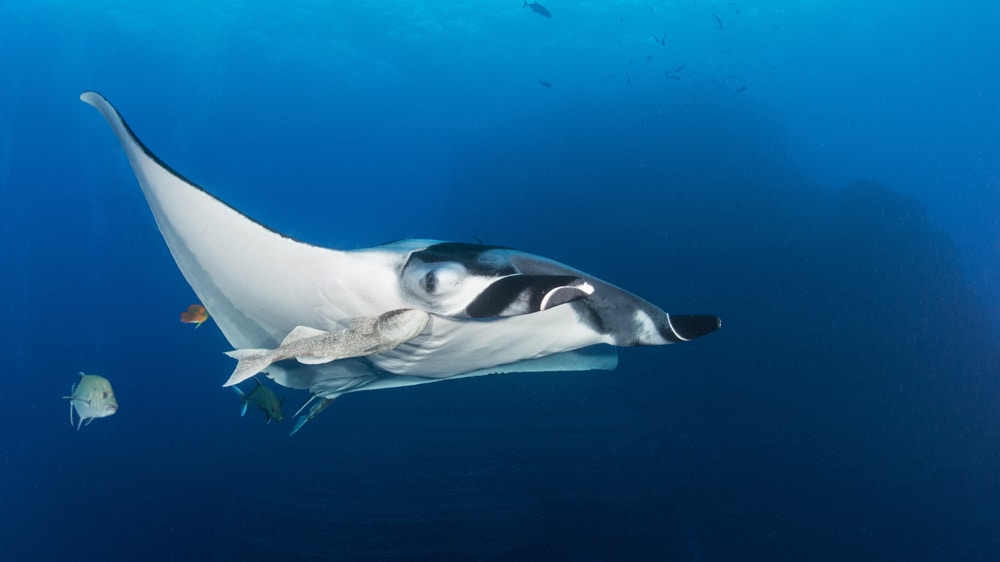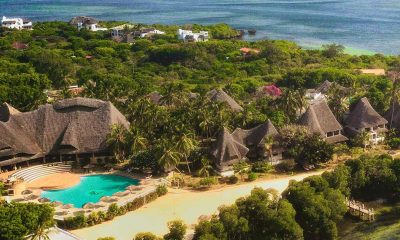Marine Life & Conservation
Komodo National Park found to be Manta Hotspot

 Through a collaborative effort between citizen divers, scientists from the Marine Megafauna Foundation (MMF), and Murdoch University, a new study reports a large number of manta rays in the waters of Komodo National Park, Indonesian, a UNESCO World Heritage Site, suggesting the area may hold the key to regional recovery of the threatened species.
Through a collaborative effort between citizen divers, scientists from the Marine Megafauna Foundation (MMF), and Murdoch University, a new study reports a large number of manta rays in the waters of Komodo National Park, Indonesian, a UNESCO World Heritage Site, suggesting the area may hold the key to regional recovery of the threatened species.
Reef mantas (Mobula alfredi), which grow up to 5m, tend to reside and feed in shallow, coastal habitats. They also visit ‘cleaning stations’ on coral reefs to have parasites, or dead skin picked off by small fish. Courtship ‘trains’ are also observed adjacent to cleaning stations. In Komodo National Park, manta rays are present year-round, challenging the famous Komodo dragon as the most sought-after megafauna for visitors.
Scientists teamed up with the dive operator community to source identification photographs of manta rays visiting the parks’ waters and submit them to MantaMatcher.org – a crowdsourced online database for mantas and other rays. Most of the photographs came from just four locations from over 20 commonly visited by tourism boats.
“I was amazed by how receptive the local dive community was in helping collect much-needed data on these threatened animals,” said lead author Dr. Elitza Germanov. “With their support, we were able to identify over 1,000 individual manta rays from over 4,000 photographs.”
“People love manta rays—they are one of the most iconic animals in our oceans. The rise of the number of people engaging in SCUBA diving, snorkeling, and the advent of affordable underwater cameras meant that photos and videos taken by the public during their holidays could be used to quickly and affordably scale data collection,” said MMF co-founder and study co-author Dr. Andrea Marshall.
The photographs’ accompanying time and location data is used to construct sighting histories of individual manta rays, which can then be analyzed with statistical movement models. These models predict the likelihood that manta rays are inhabiting or traveling in between specific sites. The study’s results showed that some manta rays moved around the park and others as far as the Nusa Penida MPA (>450 km to the west), but overall, manta rays showed individual preferences for specific sites within the Park.
“I found it very interesting how some manta rays appear to prefer spending their time in some sites more than others, even when sites are 5 km apart, which are short distances for manta rays,” said Dr. Elitza Germanov. “This means that manta rays which prefer sites where fishing activities continue to occur or that are more popular with tourism will endure greater impacts.”
Fishing activities have been prohibited in many coastal areas within Komodo NP since 1984, offering some protection to manta rays prior to the 2014 nationwide protection. However, due to illegal fishing activity and manta ray movements into heavily fished waters, manta rays continue to face a number of threats from fisheries. About 5% of Komodo’s manta rays have permanent injuries that are likely the result of encounters with fishing gear.
The popularity of tourism to these sites grew by 34% during the course of the study. An increase in human activity can negatively impact manta rays and their habitats. In 2019, the Komodo National Park Authority introduced limits on the number of boats and people that visit one of the most famous manta sites.
“This study shows that the places where tourists commonly observe manta rays are important for the animals to feed, clean, and mate. This means that the Komodo National Park should create measures to limit the disturbance at these sites,” said Mr. Ande Kefi, an employee of the Komodo National Park involved with this study. “I hope that this study will encourage tourism operators to understand the need for the regulations already imposed and increase compliance.”
Despite Indonesia’s history with intensive manta ray fisheries, Komodo National Park still retains large manta ray aggregations that with careful ongoing management and threat reduction will benefit regional manta ray populations. The study highlights that marine protected areas that are large enough to host important manta ray habitats are a beneficial tool for manta ray conservation.
For more information about MMF visit their website here.
Blogs
The Ocean Cleanup Breaks 10,000,000 KG Barrier

The Ocean Cleanup, the global non-profit project, has removed a verified all-time total of ten million kilograms (22 million lbs.) of trash from oceans and rivers around the world – approximately the same weight as the Eiffel Tower.
To complete its mission of ridding the oceans of plastic, The Ocean Cleanup uses a dual strategy: cleaning up the Great Pacific Garbage Patch (GPGP) to remove the plastic already afloat in the oceans, while stopping the flow of plastic from the world’s most polluting rivers.
Through cleaning operations in the GPGP and in rivers in eight countries, the cumulative total of trash removed has now surpassed ten million kilograms. This milestone demonstrates the acceleration of The Ocean Cleanup’s impact, while underlining the astonishing scale of the plastic pollution problem and the need for continued support and action.
While encouraging for the mission, this milestone is only a staging point: millions more tons of plastic still pollute our oceans and The Ocean Cleanup intends to continue learning, improving and innovating to solve this global catastrophe.
This announcement comes as governments from around the world meet to continue negotiations to develop a new legally binding instrument to end plastic pollution at INC4 in Ottawa, Canada. Representatives of The Ocean Cleanup will be in attendance and the organization will be urging decision-makers to collaborate towards a comprehensive and ambitious global treaty which addresses plastic at all stages of its life cycle and in all marine environments worldwide, including in areas beyond national jurisdiction.
It is encouraging to see that the need for remediation is reflected in the various options for potential treaty provisions. It is essential that the final treaty contains clear targets for the remediation of legacy plastic pollution, and reduction of riverine plastic emissions.
Tackling plastic pollution requires innovative and impactful solutions. The treaty should therefore incentivize the innovation ecosystem by fostering innovations that make maximal use of data, technology and scientific knowledge – such as those designed and deployed by The Ocean Cleanup.
‘After many tough years of trial and error, it’s amazing to see our work is starting to pay off – and I am proud of the team who has brought us to this point.’ said Boyan Slat, Founder and CEO of The Ocean Cleanup. ‘While we still have a long way to go, our recent successes fill us with renewed confidence that the oceans can be cleaned.’
The Ocean Cleanup was founded in 2013 and captured its first plastic in 2019, with the first confirmed catch in the GPGP coming soon after the deployment of Interceptor 001 in Jakarta, Indonesia. After surpassing one million kilograms of trash removed in early 2022, the non-profit project has since progressed to the third iteration of its GPGP cleaning solution, known as System 03, and a network of Interceptors currently covering rivers in eight countries, with more deployments set for 2024.
About The Ocean Cleanup
The Ocean Cleanup is an international non-profit organization that develops and scales technologies to rid the world’s oceans of plastic. They aim to achieve this goal through a dual strategy: stemming the inflow via rivers and cleaning up the legacy plastic that has already accumulated in the ocean. For the latter, The Ocean Cleanup develops large-scale systems to efficiently concentrate the plastic for periodic removal. This plastic is tracked and traced through DNV’s chain of custody model to certify claims of origin when recycling it into new products. To curb the tide via rivers, The Ocean Cleanup has developed Interceptor™ solutions to halt and extract riverine plastic before it reaches the ocean. Founded in 2013 by Boyan Slat, The Ocean Cleanup now employs a broadly multi-disciplined team of approximately 140. The foundation is headquartered in Rotterdam, the Netherlands.
For more information, visit: theoceancleanup.com and follow @theoceancleanup on social media.
Marine Life & Conservation
Steve Backshall to headline Shark Trust’s flagship event: For the Love of Sharks

Join a host of amazing, shark loving, speakers including Steve Backshall and the Shark Trust team for an evening celebrating shark conservation at the Royal Geographical Society in London this November.
Date: 29th November 2024
Time: 6-10pm
Location: Royal Geographical Society, London
Tickets: https://www.sharktrust.org/Event/flos24
The event will be a celebration of all things shark. Those lucky enough to get hold of tickets will hear from engaging guest speakers with a passion for sharks.
The line-up includes (*subject to change if unforeseen circumstances arise)
Steve Backshall: One of television’s busiest presenters, BAFTA award-winning wildlife expert Steve has been passionate about the wild world ever since he was young.
Steve’s impressive TV career has taken him all around the world, investigating a wide array of species and environments. Steve has filmed over 100 hours of children’s wildlife programmes with the BAFTA award winning Deadly 60 franchise and recently, with Sky Nature, for his new series ‘Whale with Steve Backshall’. He has been a patron for the Shark Trust for 10 years.
Simon Rogerson: is a photojournalist specialising in natural history, diving and the sea.
He is editor of SCUBA magazine, the official journal of the British Sub-Aqua Club. Simon started his career as a crime reporter but gravitated towards his ‘less depressing’ interest in underwater exploration, joining the staff of DIVE magazine in 1999. In 2005 he was named ‘Editor of the Year’ in the PPA’s Independent Publishing Awards. Simon also works as a freelance writer, contributing frequently to the Sunday Times and Telegraph, in addition to BBC Wildlife, Esquire, and a host of international diving magazines. He is the author of a book, Dive Red Sea, published by Ultimate Sports. Now based in Berkshire, Simon has been a Patron of the Shark Trust for 20 years.
More speakers to be announced soon. Head to the Shark Trust website to learn more.
The evening will also allow guests the final chance to see the Oceanic 31, shark art exhibition. Some of the artwork will be auctioned/raffled at the event, while the rest will be auctioned online to raise money for the Shark Trust Oceanic Programme.
For the Love of Sharks is an evening with something for everyone who is interested and fascinated by sharks. Join the Shark Trust, their Patrons, Trustees and Staff, along with a host of supporters for this celebration of shark conservation.
For more information or to buy a ticket: https://www.sharktrust.org/Event/flos24
-

 News3 months ago
News3 months agoCapturing Critters in Lembeh Underwater Photography Workshop 2024: Event Roundup
-

 Marine Life & Conservation Blogs3 months ago
Marine Life & Conservation Blogs3 months agoCreature Feature: Swell Sharks
-

 Blogs2 months ago
Blogs2 months agoMurex Resorts: Passport to Paradise!
-

 Gear Reviews3 weeks ago
Gear Reviews3 weeks agoGEAR REVIEW – Revolutionising Diving Comfort: The Sharkskin T2 Chillproof Suit
-

 Blogs3 months ago
Blogs3 months agoDiver Discovering Whale Skeletons Beneath Ice Judged World’s Best Underwater Photograph
-

 News2 months ago
News2 months agoPADI Teams Up with Wellness Brand Neuro to Drive Ocean Change and Create a Blue State of Mind
-

 Gear Reviews3 months ago
Gear Reviews3 months agoGear Review: Oceanic+ Dive Housing for iPhone
-

 News3 months ago
News3 months agoWorld’s Best Underwater Photographers Unveil Breathtaking Images at World Shootout 2023

















